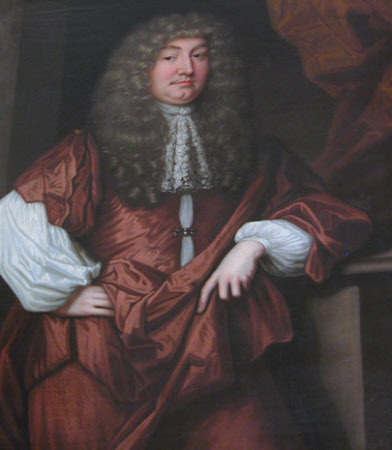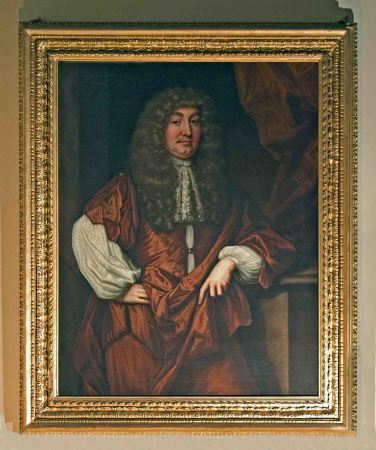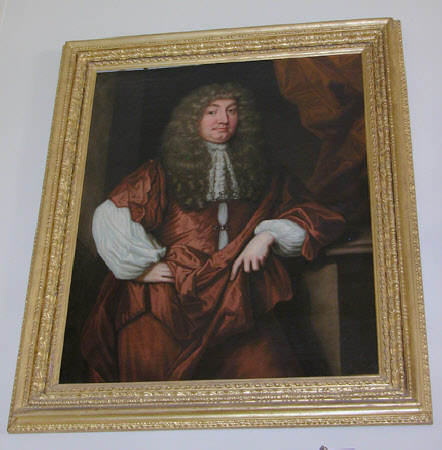Horatio Townshend, 1st Viscount Townshend (1630-1687)
attributed to Sir Ralph Cole, 2nd Baronet (c.1625 - 1704)
Category
Art / Oil paintings
Date
1650 - 1687
Materials
Oil on canvas
Measurements
1245 x 991 mm (49 x 39 in)
Place of origin
England
Order this imageCollection
Felbrigg, Norfolk
NT 1401200
Caption
The sitter worked for the restoration of Charles II, and was sent by him to The Hague in 1660. His second wife was Mary, daughter of Sir Joseph Ashe, who bore him three sons. His brother-in-law (husband of his wife’s sister, Katherine) was William I Windham (1647-89), who owned Felbrigg. Sir Ralph Cole was a gentleman, amateur artist, who worked in the manner of Lely. His first wife was a Windham, of the Kentsford branch of the family.
Summary
Oil painting on canvas, Horatio Townshend, 1st Viscount Townshend (1630-87), attributed to Sir Ralph Cole (Brancepeth c.1625 – 1704), a pupil of Sir Peter Lely. A three-quarter length portrait, turned slightly to the right, gazing at the spectator, dressed in brown cloak and full white sleeves and lace cravat. Full wig. Leaning his left arm on a pedestal. Brown curtain top right. Inscribed on the back 'Lord Townshend by P. Lely'. The gentleman-painter Sir Ralph Cole's first wife was a Windham. Horatio Townshend worked for the Restoration of Charles II and was one of the deputies sent to The Hague in 1660. Created Baron Townshend, 1661, and Viscount, 1682, he married Mary Ashe, daughter of Sir Joseph Ashe, as his second wife, in 1673, and had three sons by her (his first wife had been Mary Lewkenor, daughter and heiress of Sir Edward Lewkenor, but had no issue). He was, through her, the brother-in-law of William Windham I. Although framed as a pair to NT 1401203, the present portrait is not designed as such, nor is by the same hand, since the portrait of Mary Ashe, Lady Townshend is either a fully autograph Lely, or painted by him with the assistance of his studio, whereas the present picture has simply taken a standard Lely pattern as its model. The previous attribution to Mary Beale was taken from the list of Mary Beale's portraits by Richard Jeffree (in Mary Beale exhibition catalogue, Geffrye Museum, 1976) where it is dated to around 1680, but this was unconvincing (Malcolm Rogers agrees, oral opinion on the basis of a photograph 18/3/94). The pattern is a slight variant of one that seems to have been particularly favoured - indeed, apparently exclusively employed - by Sir Ralph Cole, as witness R. Tomson's mezzotint of his portrait of Thos. Windham Esq (Not the painting in the reverse direction at Petworth, which has a different face, hair, and sprigs of foliage), his Self-Portrait, and the portrait at Chirk (NT) attributed to him and identified as that of his cousin Robert Liddell. This particular variant of the pose, with the sitter placed indoors, and with the palm rather than the back of his right hand placed on his hip, is modelled on one that Lely used for his portrait of William, 9th Earl of Derby. It is, at first blush, a little surprising that the portraits of Lord Townshend and of his wife should be by different hands, when they are probably of much the same period, the mid-1670s, but they may not, in fact, have been acquired together. The portrait of Lord Townshend could have been given to William Windham as a brother-in-law and political ally, whereas the portrait of Mary Ashe, Lady Townshend could have come from her family at the time of her marriage or after, or subsequently by inheritance.
Provenance
Part of the Windham Collection. The hall and contents were bequeathed to the National Trust in 1969 by Robert Wyndham Ketton-Cremer (1906-1969)
Makers and roles
attributed to Sir Ralph Cole, 2nd Baronet (c.1625 - 1704), publisher previously catalogued as attributed to Mary Beale (Barrow 1633 – London 1699), publisher Sir Peter Lely (Soest 1618 – London 1680), publisher
References
The Excellent Mrs Mary Beale, (ed. Richard Jeffree), Geffrye Museum and Towner Art Gallery, Eastbourne, 1975/76, p.71, no. 132



